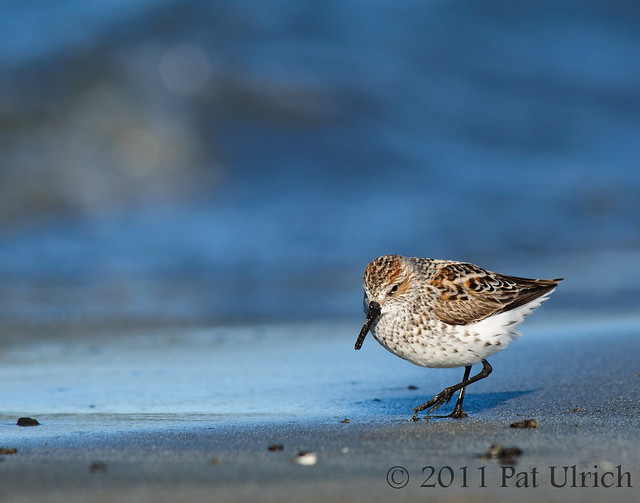
A western sandpiper in transitional plumage takes a stroll along the water's edge at Pillar Point Harbor. I've had a few comments recently that have asked about my strategy for photographing shorebirds at eye level in sandy environments. In terms of approaching birds, the further away you start belly-crawling from the better. However, since they don't always stay in the same spot for too long, you need to balance where you start with the time it will take you to get to where you want to go. I find it helpful to watch an area for a while so see where there is a lot of activity. Then I'll try to crawl into a position where I expect the birds will be heading next. For example, if they are working their way up the beach while feeding, I'll get ahead of them, pick a spot in the sand and lay down to wait for them to come to me. If they do come all the way to your spot, then you can get great close encounters since they've approached you on their terms, but sometimes I'll guess wrong and they'll head in a different direction before making it to me. But when I pick the right spots, I'll stay on the ground for as long as the birds hang around me (sometimes for as much as an hour in one place).
It's also really important to move slowly, both while getting into the prone position as well as while crawling to the birds. While I feel a little strange dropping into a kneeling position in super-slow motion, if you move normally from standing to kneeling, the birds will often take flight. So it's a slow-motion drop to my knees, then putting the tripod flat on the ground, and then a slow-motion drop to laying in the sand. At that point, the birds are much less wary, so I'll take a minute or two to assess the scene again before starting to crawl to my next location. I find it particularly helpful to crawl forward only a few yards at a time, then stop for a few minutes before proceeding. Once you've spent a good 10-15 minutes in the sand with birds, they'll often stop paying much attention to you, and then the fun really begins!
In terms of protecting my gear, I always have my camera on the tripod, with the legs spread out flat on the ground. This keeps the camera itself a few inches off of the sand. My tripod has taken a real beating this way, with plenty of sand ground into the joints, but it still works! Then I try to make a conscious effort to not touch the sand with my hands while crawling or getting up. This is especially important since my entire body will more or less be covered with sand by the time I stand up again, so there aren't too many places to wipe off my fingers. On windy days, I'll pull out my Vortex Storm Jacket camera cover, which works great for keeping the blowing sand off of the camera, as well as rain. It's inevitable that I'll get sand somewhere that I don't want it, but for the most part I can wipe it off when I'm done with no real damage incurred.
Shooting shorebirds from eye-level at the beach is one of my favorite activities, and there are plenty more images of peeps in my
Shorebirds Galleries.
